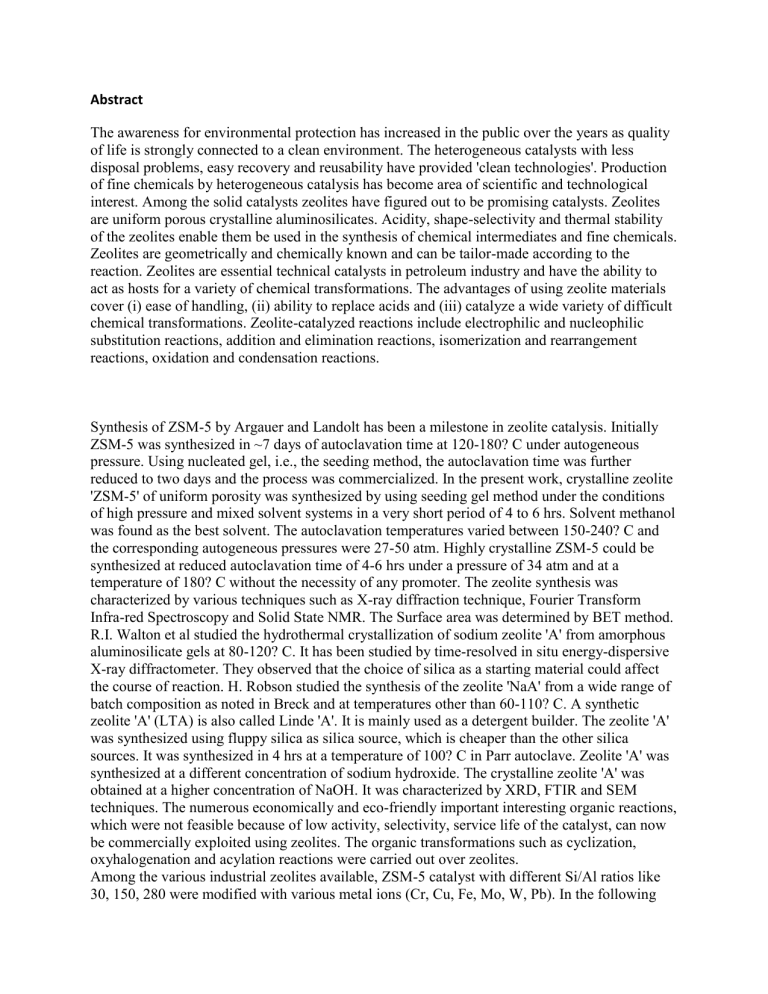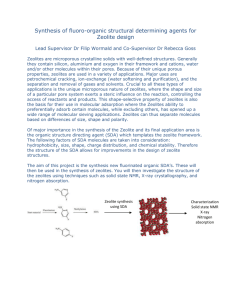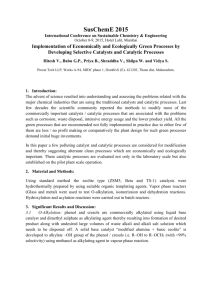Microsoft Word

Abstract
The awareness for environmental protection has increased in the public over the years as quality of life is strongly connected to a clean environment. The heterogeneous catalysts with less disposal problems, easy recovery and reusability have provided 'clean technologies'. Production of fine chemicals by heterogeneous catalysis has become area of scientific and technological interest. Among the solid catalysts zeolites have figured out to be promising catalysts. Zeolites are uniform porous crystalline aluminosilicates. Acidity, shape-selectivity and thermal stability of the zeolites enable them be used in the synthesis of chemical intermediates and fine chemicals.
Zeolites are geometrically and chemically known and can be tailor-made according to the reaction. Zeolites are essential technical catalysts in petroleum industry and have the ability to act as hosts for a variety of chemical transformations. The advantages of using zeolite materials cover (i) ease of handling, (ii) ability to replace acids and (iii) catalyze a wide variety of difficult chemical transformations. Zeolite-catalyzed reactions include electrophilic and nucleophilic substitution reactions, addition and elimination reactions, isomerization and rearrangement reactions, oxidation and condensation reactions.
Synthesis of ZSM-5 by Argauer and Landolt has been a milestone in zeolite catalysis. Initially
ZSM-5 was synthesized in ~7 days of autoclavation time at 120-180? C under autogeneous pressure. Using nucleated gel, i.e., the seeding method, the autoclavation time was further reduced to two days and the process was commercialized. In the present work, crystalline zeolite
'ZSM-5' of uniform porosity was synthesized by using seeding gel method under the conditions of high pressure and mixed solvent systems in a very short period of 4 to 6 hrs. Solvent methanol was found as the best solvent. The autoclavation temperatures varied between 150-240? C and the corresponding autogeneous pressures were 27-50 atm. Highly crystalline ZSM-5 could be synthesized at reduced autoclavation time of 4-6 hrs under a pressure of 34 atm and at a temperature of 180? C without the necessity of any promoter. The zeolite synthesis was characterized by various techniques such as X-ray diffraction technique, Fourier Transform
Infra-red Spectroscopy and Solid State NMR. The Surface area was determined by BET method.
R.I. Walton et al studied the hydrothermal crystallization of sodium zeolite 'A' from amorphous aluminosilicate gels at 80-120? C. It has been studied by time-resolved in situ energy-dispersive
X-ray diffractometer. They observed that the choice of silica as a starting material could affect the course of reaction. H. Robson studied the synthesis of the zeolite 'NaA' from a wide range of batch composition as noted in Breck and at temperatures other than 60-110? C. A synthetic zeolite 'A' (LTA) is also called Linde 'A'. It is mainly used as a detergent builder. The zeolite 'A' was synthesized using fluppy silica as silica source, which is cheaper than the other silica sources. It was synthesized in 4 hrs at a temperature of 100? C in Parr autoclave. Zeolite 'A' was synthesized at a different concentration of sodium hydroxide. The crystalline zeolite 'A' was obtained at a higher concentration of NaOH. It was characterized by XRD, FTIR and SEM techniques. The numerous economically and eco-friendly important interesting organic reactions, which were not feasible because of low activity, selectivity, service life of the catalyst, can now be commercially exploited using zeolites. The organic transformations such as cyclization, oxyhalogenation and acylation reactions were carried out over zeolites.
Among the various industrial zeolites available, ZSM-5 catalyst with different Si/Al ratios like
30, 150, 280 were modified with various metal ions (Cr, Cu, Fe, Mo, W, Pb). In the following
chapters organic transformations such as cyclization, oxyhalogenation and acylation reactions using zeolites and modified zeolites have been presented.
In the present study zeolites are used for the following organic transformations such as cyclization, oxyhalogenation and acylation reactions.
As per the literature N-methylpiperazine was formed at 30-80 atm H2 pressure and at 250-350?C temperature in the reaction of diethanolamine and methylamine over zeolites. The yield of Nmethylpiperazine was >90% at 300?C and 30 to 80 atm H2 pressure over HZSM-5 (SiO2/Al2O3
= 30). At atmospheric pressure, the yield of N-methylpiperazine and N,N'-dimethylpiperizine was <10% at 300?C. The reaction was carried out using a fixed bed down-flow reactor system.
Piperazine and substituted piperazines are the important intermediates in the synthesis of quinoline-type antibacterial drugs. In the present work N,N'-dimethylpiperazine was synthesized via intermolecular cyclization of diethanolamine and methylamine under high-pressure conditions using zeolites and montmorillonite K10 for the first time. The HZSM-5(30) is particularly effective for N,N'-dimethylpiperazine formation and the catalyst can be reused many times without significant loss of activity. N,N'-dimethylpiperazine was synthesized over zeolites under high-pressure conditions in a batch mode in the liquid phase. The reaction was carried out at 200-300? C temperature and 32-100 atm autogeneous pressure. The highest yield of N,N'dimethylpiperazine was obtained at 300? C with >90% conversion. A plausible mechanism for the formation of N,N'-dimethylpiperazine was proposed. The product was confirmed by 1H
NMR, GC-Mass and quantified by GC.
F.J. Vander Gaag et al carried out the reaction between ethanol and ammonia to yield pyridine in the presence of oxygen over ZSM-5 catalysts. In this reaction, due to oxygen in the feed, CO2 was formed as a major product. On decreasing the oxygen content of the carrier gas from 20 vol% to 1 vol%, they observed the decrease in the yield of pyridine. In the present work the reaction of ethanol, formaldehyde (40% solution) and ammonia was carried out over various modified ZSM-5 catalysts. The PbZSM-5(40) was found to be the best catalyst. The reaction was carried out over PbZSM-5(40) catalyst for 20 hrs at 410? C, 0.5 h-1 weight hourly space velocity
(WHSV) without any loss of activity of the catalyst. The reaction between acetaldehyde, formaldehyde (40% solution) and ammonia was carried out over HZSM-5, WZSM-5, PbZSM-5 with Si/Al ratios 40, 150, 300, Hb, Wb, Pbb, WZSM-5(40) catalysts at 410? C, 0.5 h-1 weight hourly space velocity (WHSV). The WZSM-5(150) was found to be the best catalyst. The reaction was carried out for 20 hrs. The high yield of pyridine and its derivatives was observed with 95-wt% of acetaldehyde conversion.
Halogenated aromatic compounds are useful intermediates as they are the precursors to organometallic species in the synthesis of a wide variety of biologically active compounds, natural products and pharmaceutically important compounds. Arylhalides can be used in the manufacture of a range of bulk and fine chemicals, including flame-retardants, disinfectants, antibacterial and antiviral drugs. The classical direct halogenations of aromatic systems suffer from the disadvantage of a byproduct, which is a hydrogen halide. In large-scale operations, this is an environmental as well as an economic problem.
Novel heterogeneous catalytic systems are designed in the present work to generate electrophilic bromine in situ from easily available KBr using, H2O2 as an oxidant. The bromine generated in situ is used for the oxybromination of aromatic compounds. This new method developed solves the disadvantages described in the earlier methods. Highly selective para-aryl bromides were synthesized over the zeolite 'ZSM-5' and modified zeolite 'ZSM-5'. It is assumed that zeolite with
H2O2 forms a peroxo species. Then it catalyzes the oxidation of Br- (KBr) to Br+ (HOBr),
which reacts in presence of Br?nsted acidic centers of zeolite with organic substrates to give brominated compounds. A new method for the selective monobromination of anilines and anisoles using NH4Br as a bromine source and H2O2 as an oxidant is reported for the first time in the present work. Adoptions of these methods involve ammonium salts, which would be more suitable for large-scale eco-friendly processes than the potassium salts. The bromination is highly para-selective for aniline itself as well as for -ortho and -meta substituted anilines. Parasubstituted anilines are brominated in the ortho position. Potassium peroxymonosulfate is an inexpensive and readily accessible oxidizing agent. It is commonly used as oxone?
(2KHSO5.KHSO4.K2SO4) and is a versatile oxidant for the transformation of a wide range of functional groups. A highly para-selective method for the oxybromination of aromatic compounds is developed in the present work using KBr as a bromine source and oxone? as an oxidant. A possible mechanism for the oxybromination of an aromatic compound in the presence of oxone? was proposed. The reaction proceeds via the formation of hypobromous acid. The hypobromous acid has higher instability due to pronouced ionic nature and thus more reactivity towards the aromatic nucleus.
In the present work the para selective (regioselective) oxychlorination of aromatic compounds was developed using commercially available oxone? as an oxidant and MCl (M=K, NH4) as a chlorine source. Chlorination was achieved without any additional catalyst. A number of different aromatic substrates were subjected to the chlorination reaction in acetonitrile solvent.
The reactions proceeded efficiently with high yields under mild conditions. The absence of sidechain chlorination products in reaction conducted in acetonitrile suggests a substantial increase in the rate of the ionic process.
A novel system was designed to generate electrophilic iodine in situ from easily available potassium iodide as an iodine source and oxone? as an oxidant for the oxyiodination. Although halogenation of aromatic compounds with halogens is a well-known reaction, bromination and chlorination easily proceed with or sometimes without Lewis acid catalysts but iodination is usually more difficult to take place. A number of different aromatic compounds were subjected to the iodination reaction to test the generality of this method.
The acylation of hydroxyl group is one of the most widely used transformations in organic synthesis. Acetic anhydride or acetylchloride is routinely employed as the acylation agent in the presence of organic bases such as triethylamine, pyridine or 4-(dimethlamino) pyridine (DMAP).
In the present work, the liquid phase acylation of primary and secondary alcohols were carried out with acetic acid in the presence of zeolites. LaY zeolite was found to be the best catalyst and its catalytic efficiency is independent of the different polarities of alcohols. The acylation of primary alcohols with acetic acid could be achieved with excellent yields at 116? C for 1-10 hrs.
Aliphatic secondary alcohols were acylated with high selectivity with a decrease in the temperature upto 80?C. The ease of separation of the product from the catalyst, excellent yield and regeneration of the catalyst are the major advantages.
Acylation of amines is one of the most important organic transformations. LiCl has been reported recently to promote the acylation of amines with acetic anhydride. The acylation of amines to the corresponding amides using acetic acid catalyzed by HY zeolite was reported. The use of acetic acid rather than acetic anhydride or acetyl chloride is economically and
environmentally advantageous. The catalyst can be reused without any loss of activity. The use of HY zeolite as a catalyst for the acylation of amines with excellent yields using acetic acid as the acetyl source has been demonstrated for the first time in the present study. The present method is applicable to a variety of alkyl, aryl and heterocyclics. The reaction proceeds smoothly at the reflux temperature of acetic acid for 5-24 hrs. The electron donating groups facilitate the reaction whereas electron-withdrawing groups slow down the reaction. Aryl amines undergo reaction at a relatively faster rate when compared to alkyl amines. A possible mechanism of this acylation was proposed. At the Br?nsted acid sites of HY zeolite the carbonyl group is protonated and the resulting acylium ion further reacts with amine to give the corresponding amide.




